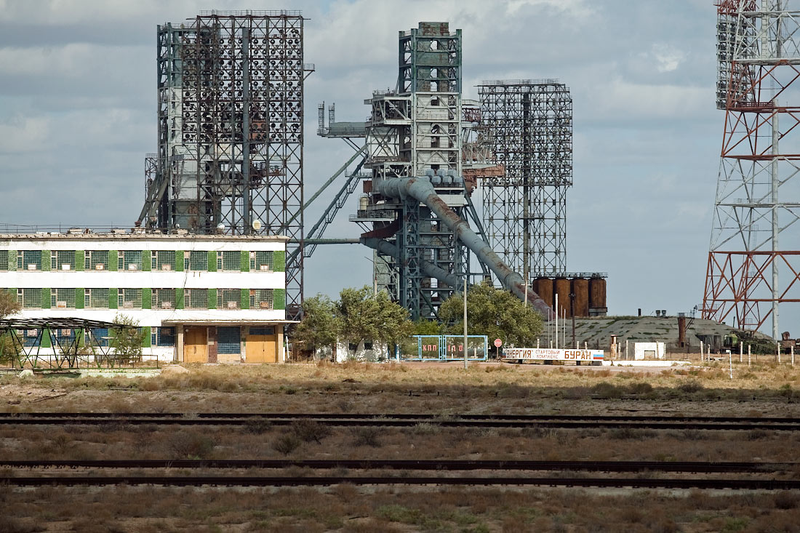

Space Shuttle, the docking compartment for Buran features an extendable tunnel to increase clearance between orbiter and station. It is a spherical compartment with a diameter of 2.67 m (8.8 ft), with a cylindrical tunnel leading to the androgynous peripheral docking unit (APAS-89). The docking module ( Стыковочный Модуль) is mounted into the forward part of the payload bay. See also: Androgynous Peripheral Attach System Shuttle Buran docked to Mir using the docking module in the forward part of the payload bay (artist concept) The cockpit is similar in layout to that of the space shuttle, with three cathode-ray tube displays. The lower deck, known as the Aggregate Compartment (AO) houses the life support system, the power supply systems and parts of the thermal control system. Up to six crew members could be seated in the middeck during launch and reentry. It contains lockers, a galley, sleeping bags and a toilet in addition to three instrument bays with radio equipment and thermal control systems. The middeck or Habitation Compartment (BO), serves as the living and sleeping quarters for the crew. The flight deck, known as the Command Compartment (KO), is the workspace for the crew and serves to accommodate the commander, pilot, engineer and mission specialist's seats, as well as the RMS operator's workplace. The crew module is an all-metal, welded, pressurised compartment housing the crew's workplaces, control and life support systems. Crew module Top of the Buran crew module, at the front of the ship, with the flight deck (Command Compartment - KO) visible through the payload bay windows. Buran has a different carbon-carbon heat tile layout in its underside, in which all gaps between heat tiles are parallel or perpendicular to the direction of airflow through the orbiter's underside, reducing heat in between heat tiles and in the boundary layer between the heat tiles and surrounding air, while helping maintain a laminar airflow through the orbiter. The Buran and space shuttle orbiters are exposed to similar temperatures, and both have similar levels of insulation. The gaps were filled with quartz fiber, rope, alkaline elements, inserts and brush seals, and the carbon-carbon heat tiles were also waterproofed. The gaps between tiles are deliberate to allow for thermal expansion. The black coating in the carbon-carbon heat tiles helps dissipate heat, and, similarly to the heat tiles used in the space shuttle, Buran heat tiles are glued to the orbiter, and the bottom of the heat tiles are left uncoated to equalize the pressure in the tile with that of its surroundings, preventing additional mechanical loads. However, the carbon-carbon Buran heat tiles have an antioxidant molybdenum disilicide coating. Similarly to US space shuttle orbiters, Buran orbiters have their exterior covered in 38,600 heat shielding tiles designed to withstand 100 reentries, which themselves were very similar to the ones in the space shuttle. Exterior Buran heat tiles visible on the OK-GLI aerotester, on display at the Technik Museum Speyer The wings of the Buran orbiter contain elevators whose position can be changed from +35° to −20°. 20% of the weight of the orbiter, while another 11% of weight is added by payload systems and removable parts. The components necessary for flight make up approx. The Buran orbiter is built around the airframe, which is its main structural component, since all other components are attached to it. Technical description Buran OK-1.01 orbiter general layout Start of comprehensive electrical testing The Buran spacecraft was made to be launched on the Soviet Union's super-heavy lift vehicle, Energia. Over 1000 companies all over the Soviet Union were involved in construction and development. The construction of the Buran spacecraft began in 1980, and by 1984 the first full-scale orbiter was rolled out. The Buran-class orbiters used the expendable Energia rocket, a class of super heavy-lift launch vehicle.īesides describing the first operational Soviet/Russian shuttle orbiter, "Buran" was also the designation for the entire Soviet/Russian spaceplane project and its flight articles, which were known as "Buran-class orbiters". īuran completed one uncrewed spaceflight in 1988, and was destroyed in the 2002 collapse of its storage hangar.

#Buran shuttle abandoned serial
Russian for "Snowstorm" or "Blizzard"īuran ( Russian: Буран, IPA:, meaning "Snowstorm" or "Blizzard" GRAU index serial number: 11F35 1K, construction number: 1.01) was the first spaceplane to be produced as part of the Soviet/Russian Buran program. Buran on An-225 at the 1989 Paris Air Show


 0 kommentar(er)
0 kommentar(er)
